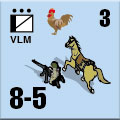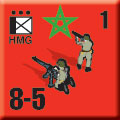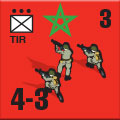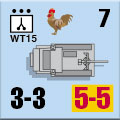Swallows of Death:
Scenario Preview, Part Three
by Mike Bennighof, Ph.D.
February 2023
 My friend Jenny Kiesling, whose real name is Eugenia, wrote a book called Arming Against Hitler that blames the state of French training for the disaster of 1940. She gently rejects Robert Doughty’s emphasis on outdated doctrine. The reservist-based structure of the French Army combined with the short period of active service made it impossible to give all French soldiers the training they needed and allow their junior officers real practice in directing them. My friend Jenny Kiesling, whose real name is Eugenia, wrote a book called Arming Against Hitler that blames the state of French training for the disaster of 1940. She gently rejects Robert Doughty’s emphasis on outdated doctrine. The reservist-based structure of the French Army combined with the short period of active service made it impossible to give all French soldiers the training they needed and allow their junior officers real practice in directing them.
Working over the scenarios for Panzer Grenadier: 1940: Swallows of Death, I can see the exception that proves Jenny’s thesis. The 1st Moroccan Division used the same doctrine as other French units, but its long-service regulars (with a leavening of French reservists) didn’t have the same problems as units raised in metropolitan France. They carried out the artillery-based defense doctrine successfully, despite not being a mechanized formation. And the glaringly obvious difference is their much more extensive training.
It's not unusual for units raised from a colonized people to fight well: Gurkhas, East African askaris, Eritreans to name just a few examples from the British, German and Italian empires. For one thing, the troops were usually volunteers. For another, having been sundered from their people, they often looked to the regiment as their nationality and fought for it with great determination.
But in the case of the Moroccans, there’s also the issue of training. They were professional soldiers who knew their business. Let’s look at their exploits during the Siege of Lille.
Chapter Three
The Lille Pocket
 The French city of Lille, within easy walking distance of the Belgian border, represented a German objective both for its heavy industry and as a communications nexus – all road and rail lines between central Belgium and the French Channel coast passed through Lille. Eventually five very good though now battered French divisions collected in Lille: two motorized infantry divisions, two North African divisions, and the 1st Moroccan Division. All told, about 40,000 French soldiers faced 160,000 Germans. The French city of Lille, within easy walking distance of the Belgian border, represented a German objective both for its heavy industry and as a communications nexus – all road and rail lines between central Belgium and the French Channel coast passed through Lille. Eventually five very good though now battered French divisions collected in Lille: two motorized infantry divisions, two North African divisions, and the 1st Moroccan Division. All told, about 40,000 French soldiers faced 160,000 Germans.
The Germans began their assault on 26 May, and soon house-to-house fighting raged in the city’s suburbs. Alphonse Juin’s 15th Motorized Infantry Division, out of food and ammunition, surrendered on 29 May, but the other four divisions fought on until 1 June. The German commander, Alfred Wäger of XXVII Corps, granted the garrison the honors of war and a final parade; this enraged Adolf Hitler who briefly fired Wäger. The German treatment of the Lille garrison would be a unique act from an army that otherwise supported a barbarous regime.
Scenario Ten
Thunder Clouds
26 May 1940
South of Carvin, France
The 1st Moroccan Division shared the defense of the Deûle canal line, east of La Bassée, with British Territorials of the 139th Brigade, 46th Division. The Allies held the canal line with a thin defense, only concentrating at a handful of potential crossing locations. German troops probed across the canal on the night of the 25th, and at 0330 German artillery opened its preliminary bombardment. The attackers – veterans of the Polish campaign – would begin their assault crossing soon.
Conclusion
During the night, the Germans had slipped a small force across the canal, and heavy fighting accompanied the new day. Throughout the morning, the Germans slowly advanced despite heavy fighting. By 1030 the Allied forward posts had been overrun and the Germans began to infiltrate between the isolated British and French companies. The British claimed that the dispirited French colonial troops gave way and withdrew first while, on the contrary, the heroes of Gembloux insisted their companies, now reduced to 50 men, battled until the end and that it was the British who withdrew. Whatever the truth of it, the situation became desperate for the Allies and although both British and Moroccan soldiers sold their lives dearly, the Germans had overcome their defenses by 1530.
Notes
While this looks at first glance like a fairly standard canal-crossing scenario (if there is such a thing), the French player has to work with allies troops who might decide it’s time to head for Dunkirk and England. The weather’s nasty, ammunition is short – and then there are the Germans.
Scenario Eleven
Company Town
26 May 1940
South of Carvin, France
 Slag heaps and workers’ housing estates surrounded Carvin, a small city south of Lille devoted to coal mining. Late in the morning of the 26th, the Germans took control of the destroyed bridge locations and St. Jean workers’ housing estate on the outskirts of Carvin. The 7th Moroccan Tirailleurs’ Heavy Weapons and Headquarters companies, with some engineers, held Carvin’s center but the Germans had surrounded some Moroccans in the St Jean estate. A French counterattack supported by five cavalry tanks set out to relieve them. Slag heaps and workers’ housing estates surrounded Carvin, a small city south of Lille devoted to coal mining. Late in the morning of the 26th, the Germans took control of the destroyed bridge locations and St. Jean workers’ housing estate on the outskirts of Carvin. The 7th Moroccan Tirailleurs’ Heavy Weapons and Headquarters companies, with some engineers, held Carvin’s center but the Germans had surrounded some Moroccans in the St Jean estate. A French counterattack supported by five cavalry tanks set out to relieve them.
Conclusion
Believing Carvin to have fallen, a nearby British brigade staff organized a counter-attack with some of their own Territorial infantry and a scattering of French units. They advanced on Carvin through heavy German fire, only to find the town still in French hands despite repeated German assaults. Rather than join the defenders, the British then withdrew again and headed for the presumed safety of the Dunkirk beaches.
Notes
This is a decidedly odd scenario, with the Moroccans holding a small slice of ground and the British relief force directly at hand, with the chance to join them before the Germans can engage. Or the British can spread out to threaten German holdings. The Germans are pretty tough, with good artillery support; the Allies have numbers and a handful of tanks.
Scenario Twelve
Escape from Carvin
27 May 1940
South-West of Lille, France
 Under cover of darkness, the remnants of 1st Moroccan Divison began to pull out of Carvin at about 0100. Their new mission would be to hold the bridges along the Deule canal and preserve the retreat route of the 2nd and 5th North African divisions. The bridges had to be held on as long as possible to allow the other French units to withdraw towards the west. At dawn, the Germans coming from La Bassée and Carvin attacked in force to close the escape roads. Under cover of darkness, the remnants of 1st Moroccan Divison began to pull out of Carvin at about 0100. Their new mission would be to hold the bridges along the Deule canal and preserve the retreat route of the 2nd and 5th North African divisions. The bridges had to be held on as long as possible to allow the other French units to withdraw towards the west. At dawn, the Germans coming from La Bassée and Carvin attacked in force to close the escape roads.
Conclusion
The Moroccans and attached French units held the bridges through the morning, but by 1400 the situation worsened. The Germans pressed the defenders hard until two Algerian battalions from 2nd North African Division, with tank support, drove off the Germans and relieved the pressure on the Moroccans. A company of Moroccans became isolated and was lost the next morning when they ran out of ammunition and surrendered after Zouaves from 5th North African Division could not break through to their rescue.
Notes
The Germans attack first, against an outnumbered but determined French/Moroccan force aided by some dispirited Brits. And then come the reinforcements, tough Algerians and Zouaves backed by tanks, as the French go over to the attack themselves. With both players having to attack and defend, with tanks and Moroccans and Zouaves, this is an extra-fun scenario.
Scenario Thirteen
At the Barricades
30 May 1940
Lille, France
 The German attack on Lille opened on 27 May with three panzer divisions attacking from west of the big city. By the next day the Germans had Lille surrounded. In the north-west suburbs, Gen. Albert Mellier arrayed the remnants of his 1st Moroccan Division to face the besiegers. The night of the 29th passed rather calmly, but by 0600 the enemy had made contact with the Moroccan outpost line. Shortly after noon, the Germans began to attack in earnest. The German attack on Lille opened on 27 May with three panzer divisions attacking from west of the big city. By the next day the Germans had Lille surrounded. In the north-west suburbs, Gen. Albert Mellier arrayed the remnants of his 1st Moroccan Division to face the besiegers. The night of the 29th passed rather calmly, but by 0600 the enemy had made contact with the Moroccan outpost line. Shortly after noon, the Germans began to attack in earnest.
Conclusion
The French refused repeated demands for their surrender, and fighting grew more intense. By 1300 German fire had disabled all of the French strongpoints along the railway line, but the Moroccan infantry pulled back inside the nearby factories to fight on the courage born of despair. In an inferno of fire, ruins and wrecks, ferocious house-to-house combat slowed the German advance to a snail’s pace. The Rue de Dunkerque leading to the railway bridge became the focal point of desperate assaults by tirailleirs, sapeurs and Zouaves to buy a few more hours. The French eventually surrendered on the afternoon of the following day.
Notes
This is a small but intense scenario, with lots of troops slugging it out in a tiny patch of dense terrain. The Moroccans and their French comrades are badly depleted but still have that high morale; the Germans are at full strength and willing to fight as well.
And that’s it for Chapter Three. Next time, Chapter Four.
You can order Swallows of Death right here.
Please allow an additional three weeks for delivery.
Sign up for our newsletter right here. Your info will never be sold or transferred; we'll just use it to update you on new games and new offers.
Mike Bennighof is president of Avalanche Press and holds a doctorate in history from Emory University. A Fulbright Scholar and NASA Journalist in Space finalist, he has published a great many books, games and articles on historical subjects; people are saying that some of them are actually good.
He lives in Birmingham, Alabama with his wife, three children, and new puppy. He misses his lizard-hunting Iron Dog, Leopold.
Want to keep Daily Content free of third-party ads? You can send us some love (and cash) through this link right here.
|
